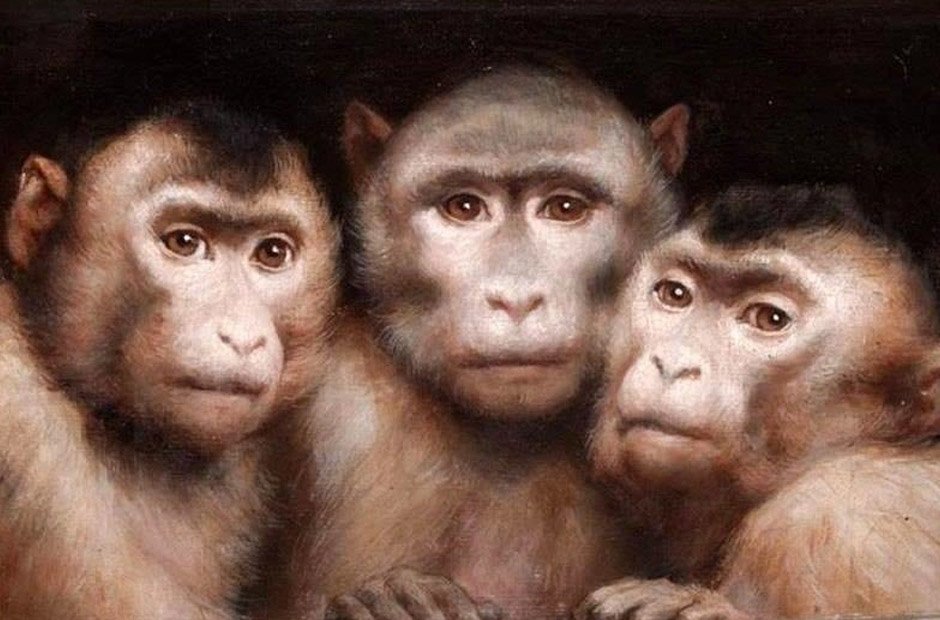Skip to the good bit
ToggleGabriel Cornelius Ritter von Max, an Austrian painter born in 1840, is a unique figure in the art world, not only for his distinctive style but also for the profound way in which he intertwined art with science. His fascination with anthropology, zoology, and human psychology deeply influenced his work, particularly his depiction of animals. This intersection of scientific inquiry and artistic expression is perhaps most vividly captured in his “Three Monkeys” artwork, a painting that encapsulates his complex understanding of both the natural world and human nature.
The Influence of Anthropology and Zoology
Von Max’s interest in anthropology and zoology was not merely a hobby; it was a driving force behind much of his artistic output. During the 19th century, Europe was experiencing a surge in scientific discoveries and a growing curiosity about the natural world. This era saw the rise of evolutionary theories, the exploration of distant lands, and a burgeoning interest in the origins of humanity. Von Max was deeply influenced by these developments. He often attended scientific lectures and collected artifacts, such as skulls and bones, which informed his understanding of both human and animal anatomy.
This scientific curiosity extended into his art, where he often depicted primates, particularly monkeys, in a way that blurred the lines between animalistic and human traits. Von Max was not just painting animals; he was exploring the connections between humans and their closest relatives in the animal kingdom. His work suggests a deep contemplation of Darwin’s theories of evolution, as well as a fascination with the idea of a shared ancestry between humans and primates.
“Three Monkeys” Artwork: A Study in Human and Animal Behavior
The “Three Monkeys” artwork is one of von Max’s most famous pieces and serves as a perfect example of how his scientific interests influenced his art. The painting features three monkeys sitting together, each one embodying a different aspect of the proverb “See no evil, hear no evil, speak no evil.” However, von Max’s interpretation of these monkeys goes beyond the simple proverb. The way he has rendered these creatures reflects his understanding of both animal behavior and human psychology.
The monkeys in the painting are not merely animals; they are anthropomorphized to reflect human concerns and moral dilemmas. Their postures and expressions convey a sense of contemplation, almost as if they are aware of the human condition they are meant to represent. This blending of human and animal characteristics speaks to von Max’s belief in the interconnectedness of all living beings. It also reflects his interest in the cognitive abilities of animals, particularly primates, which were a subject of significant scientific study during his time.
The “Three Monkeys” artwork is a visual representation of the idea that animals, particularly those so closely related to humans, can exhibit behaviors and emotions that are strikingly similar to our own. Von Max’s portrayal of these monkeys challenges the viewer to consider the moral and ethical implications of their actions, much as one would when observing human behavior.
Art as a Medium for Scientific Exploration
For von Max, art was not just a means of aesthetic expression but also a medium through which he could explore and communicate scientific ideas. His animal studies, including the “Three Monkeys” artwork, often served as a bridge between the disciplines of art and science. By depicting animals with such detailed accuracy and emotional depth, von Max invited viewers to engage with the natural world in a more thoughtful and informed way.
In many of his works, von Max used animals to comment on human society and its values. The monkeys in his paintings, for example, often serve as stand-ins for humans, allowing von Max to explore themes such as morality, intelligence, and the nature of consciousness. His ability to infuse his animal subjects with human-like qualities reflects his belief in the shared traits between species and his interest in the broader questions of existence.
The Legacy of von Max’s Animal Studies
Gabriel Cornelius Ritter von Max’s work remains a fascinating example of how art can intersect with science. His detailed and empathetic portrayals of animals, particularly in the “Three Monkeys” artwork, offer a glimpse into the mind of an artist who saw the natural world as a rich source of inspiration and inquiry. Von Max’s paintings continue to resonate with modern audiences, not only for their technical skill and beauty but also for their ability to provoke thought about the relationships between humans and animals.
In today’s world, where the lines between disciplines are increasingly blurred, von Max’s work serves as a reminder of the power of interdisciplinary thinking. His ability to merge his passion for science with his talent for art created works that are both visually striking and intellectually stimulating. The “Three Monkeys” artwork, in particular, stands as a testament to his unique approach, offering a complex and layered commentary on the human condition as seen through the eyes of our closest animal relatives.
Gabriel Cornelius Ritter von Max’s animal studies, infused with scientific curiosity and artistic brilliance, challenge us to look beyond the surface and consider the deeper connections between all living beings. His legacy is one of a visionary who used art to explore and communicate the mysteries of life, leaving behind a body of work that continues to inspire and intrigue.







